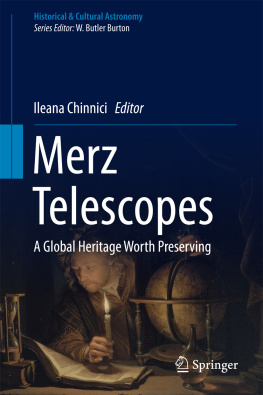Chinnici - Merz Telescopes A global heritage worth preserving
Here you can read online Chinnici - Merz Telescopes A global heritage worth preserving full text of the book (entire story) in english for free. Download pdf and epub, get meaning, cover and reviews about this ebook. City: Cham, year: 2017;2018, publisher: Springer International Publishing, genre: Home and family. Description of the work, (preface) as well as reviews are available. Best literature library LitArk.com created for fans of good reading and offers a wide selection of genres:
Romance novel
Science fiction
Adventure
Detective
Science
History
Home and family
Prose
Art
Politics
Computer
Non-fiction
Religion
Business
Children
Humor
Choose a favorite category and find really read worthwhile books. Enjoy immersion in the world of imagination, feel the emotions of the characters or learn something new for yourself, make an fascinating discovery.
- Book:Merz Telescopes A global heritage worth preserving
- Author:
- Publisher:Springer International Publishing
- Genre:
- Year:2017;2018
- City:Cham
- Rating:5 / 5
- Favourites:Add to favourites
- Your mark:
- 100
- 1
- 2
- 3
- 4
- 5
Merz Telescopes A global heritage worth preserving: summary, description and annotation
We offer to read an annotation, description, summary or preface (depends on what the author of the book "Merz Telescopes A global heritage worth preserving" wrote himself). If you haven't found the necessary information about the book — write in the comments, we will try to find it.
Chinnici: author's other books
Who wrote Merz Telescopes A global heritage worth preserving? Find out the surname, the name of the author of the book and a list of all author's works by series.
Merz Telescopes A global heritage worth preserving — read online for free the complete book (whole text) full work
Below is the text of the book, divided by pages. System saving the place of the last page read, allows you to conveniently read the book "Merz Telescopes A global heritage worth preserving" online for free, without having to search again every time where you left off. Put a bookmark, and you can go to the page where you finished reading at any time.
Font size:
Interval:
Bookmark:

- (a) An equatorial mounting which became known as a German equatorial mounting (or simply a German mounting). It consisted essentially of a T-shape structure, whose lower bar, aligned with the celestial pole, is called the right ascension axis and the upper transversal bar is the declination axis. The telescope was placed on one end of the declination axis. This mounting also allowed observations in the direction of the celestial pole.
- (b) Two large divided circles with verniers for reading scales.
- (c) A centrifugal driving mechanism that allows the device to follow a celestial body automatically, by compensating for the apparent movement of the sky.
- (d) A perfectly balanced wooden tube, having two parallel bars with counterweights which reduce its flexion.
- (e) A large (24 cm of aperture) and perfectly executed achromatic objective with a series of eyepieces, including a micrometric eyepiece. This was the largest objective-lens of that time.

Font size:
Interval:
Bookmark:
Similar books «Merz Telescopes A global heritage worth preserving»
Look at similar books to Merz Telescopes A global heritage worth preserving. We have selected literature similar in name and meaning in the hope of providing readers with more options to find new, interesting, not yet read works.
Discussion, reviews of the book Merz Telescopes A global heritage worth preserving and just readers' own opinions. Leave your comments, write what you think about the work, its meaning or the main characters. Specify what exactly you liked and what you didn't like, and why you think so.





![Mario V. Wüthrich - Statistical Foundations of Actuarial Learning and its Applications (2022) [Wüthrich Merz] [9783031124099]](/uploads/posts/book/376461/thumbs/mario-v-w-thrich-statistical-foundations-of.jpg)
